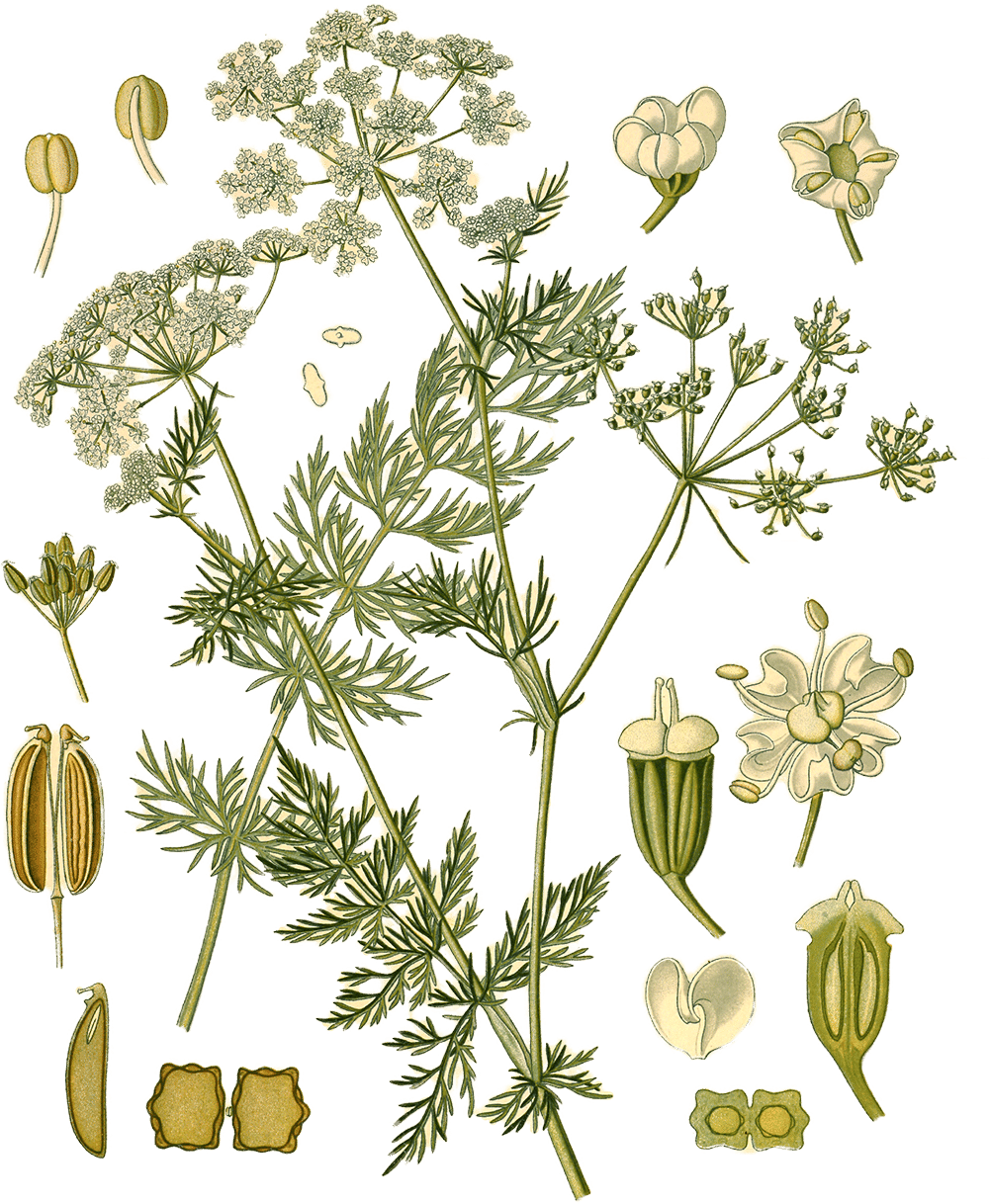Caraway #

Illustration of Carum carvi L. from Köhler's Medizinal-Pflanzen (1887)
Caraway (Carum carvi L.) is a culinary spice from the Apiaceae family,1 originating in the region(s) of Mediterranean; Eurasia.2 It is used for its fruit, primarily for breads, sausages, cheese; carminative. Its aroma is described as warm, sweet, anise-like, with a heat index of 1.3
| English | Arabic | Chinese | Hungarian |
|---|---|---|---|
| caraway | كراويا | 葛縷子 | fűszerkömény |
Overview #
| id | caraway |
|---|---|
| species name | Carum carvi L. |
| family | Apiaceae |
| part used | fruit |
| macroarea | Eurasia |
| region of origin | Mediterranean; Eurasia |
| cultivation | Denmark; Lebanon; The Netherlands; Poland |
| color | dark brown |
| botanical database | POWO |
Etymologies #
English caraway ‘caraway’, ca. 1440 < Medieval Latin carui ‘caraway’, or some allied Romanic form, ca. 1080; cf. cognates French carvi, Italian carvi, Spanish carvi; Old Spanish alcaravea, alcarahueya, Portuguese alcaravia, alcorovia < Arabic كراويا karāwiyā ‘caraway’, (loaned to some Eurropean languages with al- definite article, via Andalusian Arabic) < Aramaic / karwāyā ‘caraway’ < Ancient Greek καρώ karṓ ‘caraway’, a form of the word káron, derived from káre ‘head’; -ṓ form seems Pre-Greek (these forms could not immediately give the Arabic, hence possibly via *καρυΐα * karuḯa a typical plant derivation form of καρώ karṓ, κάρον káron); cf. cognates Latin carum, careum
Arabic karawiyā ‘caraway’, (loaned to some Eurropean languages with al- definite article; via Andalusian Arabic) < Aramaic / karwāyā ‘caraway’ < Ancient Greek καρώ karṓ ‘caraway’, a form of the word káron, derived from káre ‘head’; -ṓ form seems Pre-Greek (these forms could not immediately give the Arabic, hence possibly via *καρυΐα * karuḯa a typical plant derivation form of καρώ karṓ, κάρον káron); cf. cognates Latin carum, careum
Mandarin Chinese 葛縷子 gělǚzi ‘caraway’ [bean-hemp-seed? ], phono-semantic matching; see shilo ‘cumin and caraway’ < Japanese 葛縷子 karyuushi ‘caraway’, probably a transcription of Latin Carui, or English caraway + zi (also キャラウェイ kyarawei and 姫茴香 [princess-fennel-spice ]), 1822 < from English caraway ‘caraway’, ca. 1440 or from Medieval Latin carui ‘caraway’, or some allied Romanic form; cf. cognates French carvi, Italian carvi, Spanish carvi (whence Scots carvy, kervie), Old Spanish alcaravea, alcarahueya, Portuguese alcaravia, alcorovia < Arabic كراويا karāwiyā ‘caraway’, (loaned to some Eurropean languages with al- definite article; via Andalusian Arabic) < Aramaic / karwāyā ‘caraway’ < Ancient Greek καρώ karṓ ‘caraway’, a form of the word káron, derived from káre ‘head’; -ṓ form seems Pre-Greek (these forms could not immediately give the Arabic, hence possibly via *καρυΐα * karuḯa a typical plant derivation form of καρώ karṓ, κάρον káron); cf. cognates Latin carum, careum
Names #
English #
| term | source |
|---|---|
| caraway | OED |
| Armenian cumin | OED |
| caraway-seed | OED |
| meridian fennel | Wikipedia |
| mountain cumin | OED |
| Persian cumin | Wikipedia |
| royal cumin | OED |
Arabic #
| script | term | literal | source |
|---|---|---|---|
| كراويا | karāwiyā | Wehr, 1976 |
Chinese #
| script | term | literal | source |
|---|---|---|---|
| 葛縷子 | gělǚzi | Kleeman, 2010 | |
| 藏茴香 | zànghuíxiāng | Tibetan-hui-spice | MDBG |
| 頁蒿 | yèhāo | leaf-wormwood | MDBG |
POWO. (2022). Plants of the World Online (Botanical Database). Facilitated by the Royal Botanic Gardens, Kew. http://www.plantsoftheworldonline.org/ ↩︎
van Wyk, B.-E. (2014). Culinary Herbs and Spices of the World. University of Chicago Press, joint publication with the Royal Botanic Gardens, Kew. https://doi.org/10.7208/chicago/9780226091839.001.0001 ↩︎
Medicinal Spices Exhibit. (2002). UCLA Biomedical Library: History & Special Collections. https://unitproj.library.ucla.edu/biomed/spice/index.cfm?spicefilename=taste.txt&itemsuppress=yes&displayswitch=0 ↩︎